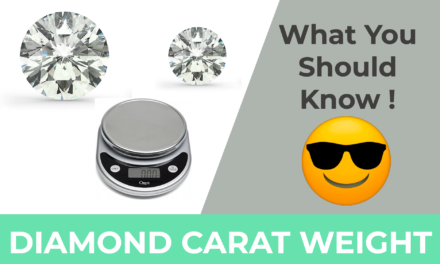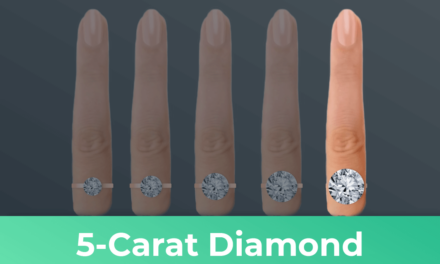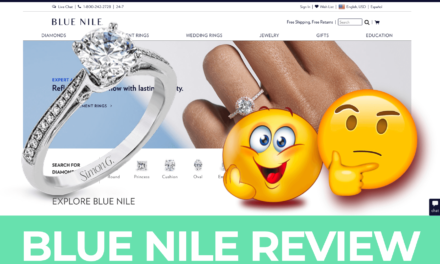My website is reader-supported. Buying through links on my site may result in me earning a CUSTOMER REFERRAL FEE at no extra cost to you.
Check out the latest deals at our top diamond vendor choice: James Allen
Bezel Setting – Pros and Cons You Need to Know!
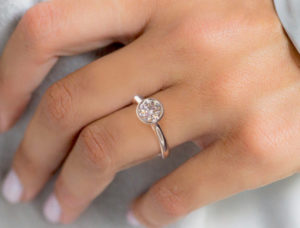
Should you get a bezel setting or not?
When shopping for an engagement ring, one of the decisions you’ll need to make is what type of setting to choose. There are many different settings available, each with its own set of pros and cons.
In this post, we’ll take a look at bezel rings and list the pros and cons of choosing this type of setting.
By the end of this post, you’ll have a good understanding of whether or not this type of ring setting is right for you.
Jump to the section:
- How does a bezel set engagement ring work?
- Difference between a full and a partial bezel setting
- The full bezel setting
- The partial bezel ring
- Pros of a bezel ring setting
- Cons of a bezel ring setting
- The popularity of a bezel set engagement ring
- Shopping recommendations & inspiration
How does a Bezel Set Engagement Ring work?
The bezel setting is a very popular choice for people shopping for engagement ring settings. With this engagement ring style, the diamond is held in place by a thin customized metal rim instead of prongs like in other engagement ring settings. The precious metal rim encircles the stone so that it stays secure.
Bezel Settings vs. Prong Settings
Bezel and prong settings are two popular methods of securing a gemstone in a jewelry piece. Both have their own advantages and disadvantages.
Bezel settings are a type of prong setting where the metal extends beyond the gemstone to hold it in place. This creates a more secure setting and is often used for stones that are prone to slipping out of their settings, such as opals. The bezel setting can also be used to create a more refined or delicate look, as there is no metal protruding from the sides of the stone.
The prong setting is the most common type of setting, where the metal protrudes from the sides of the stone to secure it in place. This setting is less secure than the bezel setting, but it is more affordable and easier to repair. The prong setting also allows more light to enter the stone, which can be advantageous for certain gems.
To get a better idea of how a bezel set ring works, take a look at how the diamond is secured in this bezel setting from James Allen compared to this prong setting.
When choosing between bezel settings and prong settings, consider the security of the stone, the affordability, and the look that you are trying to achieve. Both settings have their own unique benefits, so choose the one that best suits your needs.
Difference Between a Full and a Partial Bezel Diamond Ring
Full bezel settings have the rim totally surrounding the diamond, as seen in this halo style bezel setting. On the other hand, a partial bezel ring setting has open sides, as seen in this half bezel set on a pave band. Whether you choose a full or partial bezel, your diamond will be securely held in place.
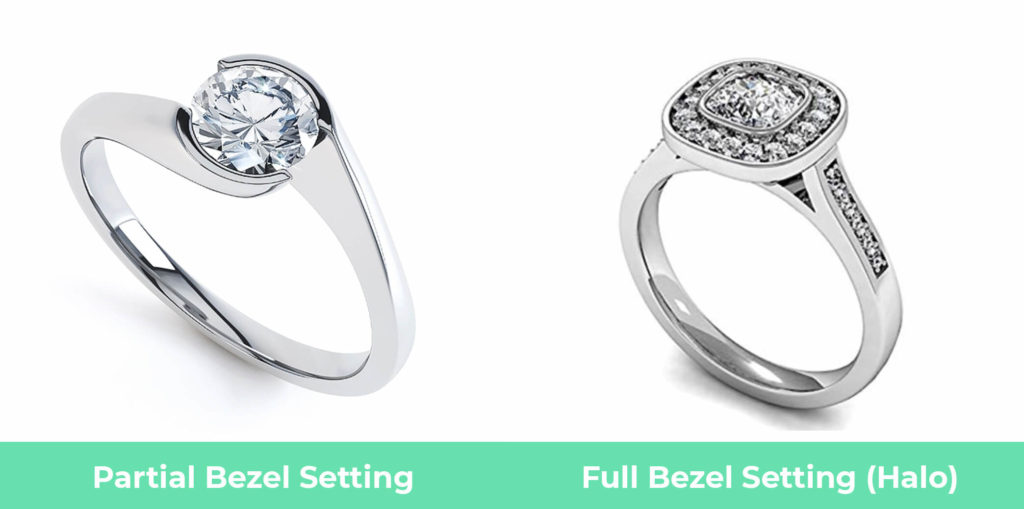
Bezel engagement rings look modern and sleek. But they are versatile and can also look somewhat vintage or art deco, as you can see in this flowering engagement ring.
By the way, if you are looking for a Bezel Setting at James Allen, you won’t actually find a section with that category. You’d have to go to “Tension Settings” instead, where you’ll find several Bezels.
Variations of the Bezel Diamond Ring
Bezel settings are sometimes called a Rub Over set or Collet set and come in several variations. Most customers choose a round diamond, but almost any other shape is possible, too. A talented jeweler can create this setting for a pear-shaped diamond, a heart, a brilliant and other shapes as well.
Full Bezel Setting
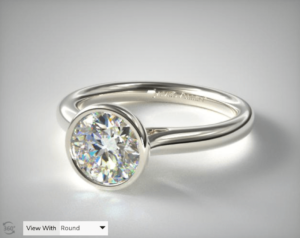 As mentioned earlier, with a full bezel the metal rim totally surrounds the stone in the center, covering all edges. This setting protects the edges the most, making them less at risk of chipping.
As mentioned earlier, with a full bezel the metal rim totally surrounds the stone in the center, covering all edges. This setting protects the edges the most, making them less at risk of chipping.
The downside is that the full version of the diamond is hidden. This makes the diamond look smaller because you can’t see the full brilliance of the diamond. This means the diamond will only sparkle from above and not the sides. This means your diamond will look smaller and not as brilliant.
Partial Bezel Settings
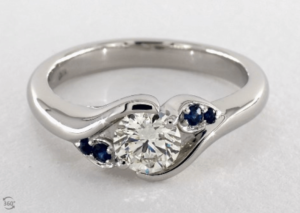 As the name implies, a partial setting just encircles parts of the stone. Because you are able to see the edge of the stone from two sides, the diamond looks larger. Furthermore, the sides are exposed, so light can reflect off those areas. This gives the stone more brilliance than you would get from a full setting.
As the name implies, a partial setting just encircles parts of the stone. Because you are able to see the edge of the stone from two sides, the diamond looks larger. Furthermore, the sides are exposed, so light can reflect off those areas. This gives the stone more brilliance than you would get from a full setting.
Bezels have their advantages and disadvantages, just like most everything. In the end, it comes down to personal preference.
Pros of a Bezel Settings
It Will Protect The Center Diamond
Bezels are extremely secure if you’re worried about your diamond coming loose. Unlike prong settings, it offers the center stone added protection from an impact and prevents its edges from chipping. This can be critical if the diamond has sharp edges, which are more at risk of chipping, like marquise, pear and princess cuts.
Since this setting offers added protection for the stone, it’s perfect for people with an active lifestyle because it can survive the potentially rougher treatment. So, if you are looking for a setting that holds the diamond securely, this might be the right setting for you!
It Will Not Snag Clothing
This kind of setting will not snag your clothing or other items like prong settings commonly do. For example, if you work in retail selling clothing, your ring won’t snag the inventory. That’s why this type of setting is a popular choice for people with an active life style.
Bezel Set Diamonds Also Hide Flaws
Another advantage of this setting is that it can conceal inclusions and other flaws that may exist along the edges of a diamond. For example, if the diamond has a visible chip along the edge, the bezel can completely hide it. However, if the flaw happens to be in the center of the stone, this type of setting would instead tend to draw attention to it.
Cons of a Bezel Setting
It Will Make The Center Stone Look Smaller And Diminish Its Sparkle
 With a prong setting, you can see the vast majority of the diamond, which enhances its size and increases its brilliance due to enhanced light reflecting from the stone. On the other hand, a bezel will conceal a good portion of the diamond. This makes it look smaller while diminishing its sparkle. But, a lot of this depends on how the stone is set within the bezel, how thin the metal rim is surrounding the stone as well as the band’s width.
With a prong setting, you can see the vast majority of the diamond, which enhances its size and increases its brilliance due to enhanced light reflecting from the stone. On the other hand, a bezel will conceal a good portion of the diamond. This makes it look smaller while diminishing its sparkle. But, a lot of this depends on how the stone is set within the bezel, how thin the metal rim is surrounding the stone as well as the band’s width.
With this setting, if the jeweler sets the stone low, right on the band itself, it will look smaller. If, on the other hand, the stone is set high above the band, like in the above photo, the diamond will appear larger and more prominent.
A Bezel Engagement Ring Setting is More Expensive Than a Regular Setting
A bezel tends to be more expensive than a traditional prong setting because it requires more expertise and more metal to create it. On top of that, a bezel setting is customized to precisely fit the stone. The additional skill, work, and metal needed to create the setting can’t help but increase the cost.
If you look at James Allen’s website, you will see that a basic 18K prong setting in white gold can be purchased for about $190. But the exact same band will cost you $800 if it has a bezel setting. If you’re on a strict budget, you may want to choose a prong setting.
It Has a Lot of Versatility
The bezel is not a feature of the setting’s design. It is just how the diamond is being held within the setting’s design. This means that a this kind of setting can be used in a wide variety of designs.
You can choose a three-stone ring design, pave, halo, vintage or solitaire design and still use a bezel setting if you would prefer that over prongs.
You can also choose different diamond shapes and metals. For example, you could choose a yellow gold ring or a white gold ring.
The most popular choice, however, is a white gold ring setting with a single brilliant cut diamond as the center stone.
Is This Type of Ring Setting Popular As A Diamond Engagement Ring?
This versatile setting is quite popular. It regularity ranks on the 5th or 6th place of most popular engagement ring settings. However, it is far less popular than a more traditional diamond engagement ring setting like the solitaire or other prong settings.
Shopping Recommendations & Inspiration
 You need a highly skilled jeweler to create this type of setting, which means you could only get one from a reputable jeweler.
You need a highly skilled jeweler to create this type of setting, which means you could only get one from a reputable jeweler.
Our recommendation would be to shop at James Allen because they are the best when it comes to shopping online for diamond engagement rings. You will surely find a broad range of engagement rings and various settings and can even design your own!


